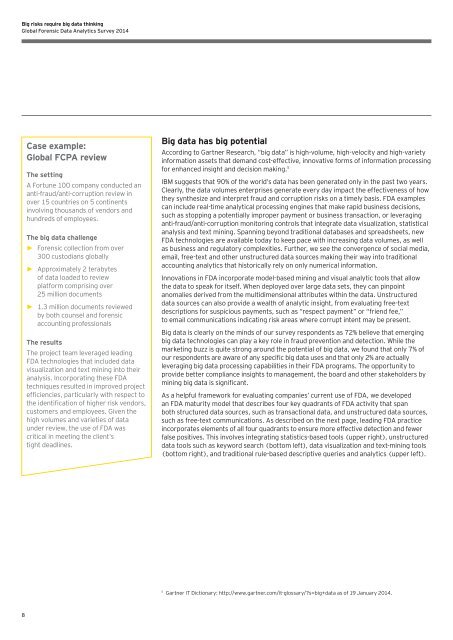EY-Global-Forensic-Data-Analytics-Survey-2014
EY-Global-Forensic-Data-Analytics-Survey-2014
EY-Global-Forensic-Data-Analytics-Survey-2014
You also want an ePaper? Increase the reach of your titles
YUMPU automatically turns print PDFs into web optimized ePapers that Google loves.
Big risks require big data thinking<br />
<strong>Global</strong> <strong>Forensic</strong> <strong>Data</strong> <strong>Analytics</strong> <strong>Survey</strong> <strong>2014</strong><br />
Case example:<br />
<strong>Global</strong> FCPA review<br />
The setting<br />
A Fortune 100 company conducted an<br />
anti-fraud/anti-corruption review in<br />
over 15 countries on 5 continents<br />
involving thousands of vendors and<br />
hundreds of employees.<br />
The big data challenge<br />
►►<br />
<strong>Forensic</strong> collection from over<br />
300 custodians globally<br />
►►<br />
Approximately 2 terabytes<br />
of data loaded to review<br />
platform comprising over<br />
25 million documents<br />
►►<br />
1.3 million documents reviewed<br />
by both counsel and forensic<br />
accounting professionals<br />
The results<br />
The project team leveraged leading<br />
FDA technologies that included data<br />
visualization and text mining into their<br />
analysis. Incorporating these FDA<br />
techniques resulted in improved project<br />
efficiencies, particularly with respect to<br />
the identification of higher risk vendors,<br />
customers and employees. Given the<br />
high volumes and varieties of data<br />
under review, the use of FDA was<br />
critical in meeting the client’s<br />
tight deadlines.<br />
Big data has big potential<br />
According to Gartner Research, “big data” is high-volume, high-velocity and high-variety<br />
information assets that demand cost-effective, innovative forms of information processing<br />
for enhanced insight and decision making. 5<br />
IBM suggests that 90% of the world’s data has been generated only in the past two years.<br />
Clearly, the data volumes enterprises generate every day impact the effectiveness of how<br />
they synthesize and interpret fraud and corruption risks on a timely basis. FDA examples<br />
can include real-time analytical processing engines that make rapid business decisions,<br />
such as stopping a potentially improper payment or business transaction, or leveraging<br />
anti-fraud/anti-corruption monitoring controls that integrate data visualization, statistical<br />
analysis and text mining. Spanning beyond traditional databases and spreadsheets, new<br />
FDA technologies are available today to keep pace with increasing data volumes, as well<br />
as business and regulatory complexities. Further, we see the convergence of social media,<br />
email, free-text and other unstructured data sources making their way into traditional<br />
accounting analytics that historically rely on only numerical information.<br />
Innovations in FDA incorporate model-based mining and visual analytic tools that allow<br />
the data to speak for itself. When deployed over large data sets, they can pinpoint<br />
anomalies derived from the multidimensional attributes within the data. Unstructured<br />
data sources can also provide a wealth of analytic insight, from evaluating free-text<br />
descriptions for suspicious payments, such as “respect payment” or “friend fee,”<br />
to email communications indicating risk areas where corrupt intent may be present.<br />
Big data is clearly on the minds of our survey respondents as 72% believe that emerging<br />
big data technologies can play a key role in fraud prevention and detection. While the<br />
marketing buzz is quite strong around the potential of big data, we found that only 7% of<br />
our respondents are aware of any specific big data uses and that only 2% are actually<br />
leveraging big data processing capabilities in their FDA programs. The opportunity to<br />
provide better compliance insights to management, the board and other stakeholders by<br />
mining big data is significant.<br />
As a helpful framework for evaluating companies’ current use of FDA, we developed<br />
an FDA maturity model that describes four key quadrants of FDA activity that span<br />
both structured data sources, such as transactional data, and unstructured data sources,<br />
such as free-text communications. As described on the next page, leading FDA practice<br />
incorporates elements of all four quadrants to ensure more effective detection and fewer<br />
false positives. This involves integrating statistics-based tools (upper right), unstructured<br />
data tools such as keyword search (bottom left), data visualization and text-mining tools<br />
(bottom right), and traditional rule-based descriptive queries and analytics (upper left).<br />
5<br />
Gartner IT Dictionary: http://www.gartner.com/it-glossary/?s=big+data as of 19 January <strong>2014</strong>.<br />
8


